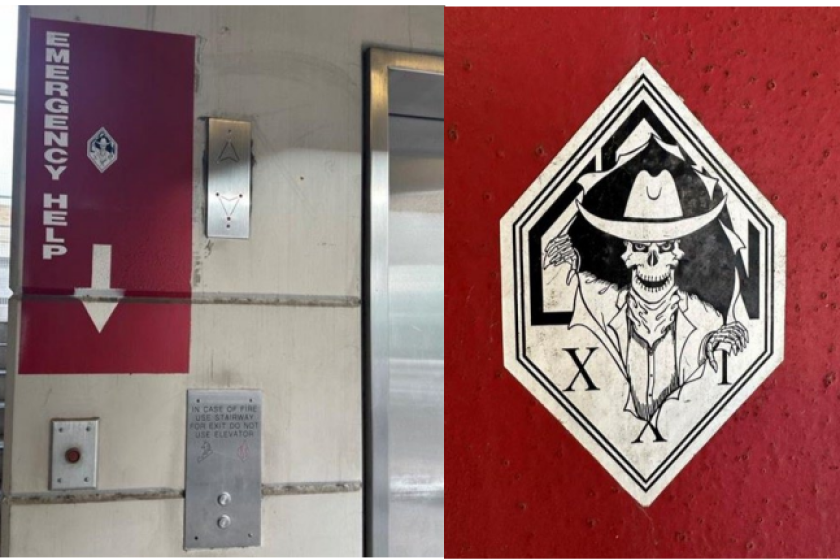County watchdog urges disbanding of sheriff’s ‘aggressive’ Risk Management Bureau

Oversight officials this month urged the Los Angeles County Sheriff’s Department to disband a specialized bureau they say is silencing whistleblowers, protecting favored employees and downplaying misconduct in the upper ranks.
The job of the 83-person Risk Management Bureau is to help the Sheriff’s Department minimize its liability by avoiding accidents and defending against lawsuits. But the L.A. County Office of Inspector General’s latest report, released Feb. 20, describes a historically “flawed” bureau that became “inappropriately aggressive” under the prior sheriff and has not improved under the current one.
In one instance, the report said, the bureau appeared to retaliate against a whistleblowing deputy by wrongly reporting him to state oversight authorities for dishonesty, an accusation that could have caused him to lose his law enforcement certification permanently.
Yet, repeatedly, the bureau failed to report to state authorities allegations suggesting possible deputy gang membership — even after one deputy named names in court. And when former Sheriff Alex Villanueva and several top aides were caught on tape “lying to a reporter” about a photo-sharing scandal, the department failed to investigate at all, the report said.
Then-Capt. Jorge Valdez and then-Lt.
“The euphemistically named bureau corrupts the county’s efforts to improve government conduct,” the report said, describing the utilization of law enforcement “to protect the Sheriff’s Department” from citizens seeking redress as a “misuse of government resources.”
In a six-page response, Sheriff Robert Luna criticized the recommendation and called the report “speculative, unfair and irresponsible.”
The blistering report and the sheriff’s pointed response appear to signal a shift in relations between the county’s top cop and the inspector general, which had generally been amiable — at least in public — since Luna took office in December 2022.
Under his administration, Luna wrote, the Sheriff’s Department has reported more than 3,600 instances of serious misconduct — including 128 allegations of deputy gang membership — to state authorities who oversee the certification and decertification of law enforcement officers.
In his letter, the sheriff criticized oversight officials for failing to acknowledge changes under his administration and said that many departments have similar structures. He called the report’s examples “anecdotal” and questioned why oversight officials did not visit the Risk Management Bureau to better understand its operations.
“The Department is in fact obligated to mitigate risk, appropriately support the goal of reducing liability and ensuring root causes are identified and corrective actions are implemented,” he wrote. “The draft report includes gratuitous attacks on Department personnel that include assumptions about motive and intent that is not supported by any evidence.”
On Monday, the Sheriff’s Department told The Times it would not follow the recommendation to disband the Risk Management Bureau. Officials also said the bureau’s captain has been temporarily reassigned but “not because of work performance.”
*************
Until recently, California was one of few states with no way to permanently bar bad cops from continuing to work in law enforcement. But in January 2023, a new law, SB 2, took effect. It allows the state’s Commission on Police Officer Standards and Training, or POST, to permanently decertify those who lie, join gangs or commit other specific kinds of serious misconduct. In Los Angeles, the Sheriff’s Department charged its Risk Management Bureau with referring qualifying cases to state authorities for consideration.
How fairly the bureau is doing that is one of the central questions in the inspector general’s report.
The state’s Commission on Peace Officer Standards and Training estimated that it might decertify more than 3,000 police officers yearly under a long-overdue reform.
In January 2023 — the same month the law took effect — lawyers for the county deposed a whistleblower who’d accused officials of failing to protect him from a deputy gang known as the Banditos. According to the oversight report, the questions focused on finding inconsistencies in his prior reports and testimony.
Six days after the deposition, the Sheriff’s Department reported the deputy to POST for dishonesty, claiming he “admitted under oath he was dishonest.” But when oversight investigators reviewed the transcript, they discovered that was not true. Instead, the report said, he’d admitted only that one answer “wasn’t accurate” and never admitted to making false statements or intentionally leaving out information.
When the deputy later resigned while under investigation for an unrelated matter, the Sheriff’s Department told POST he had resigned pending an investigation involving dishonesty — which was also not true, the report said. After the deputy’s attorney and the inspector general raised concerns, the Sheriff’s Department sent a formal correction to state authorities.
“This aggressive approach to SB 2 reporting as to a whistleblower is in sharp contrast to the approach the Department takes in other cases,” the report said, “particularly those raising claims against management.”
In October, the County Equity Oversight Panel recommended that Villanueva be considered ineligible for rehire after finding that he had harassed and discriminated against Inspector General Max Huntsman and another county employee. Under SB 2, bias by a peace officer is considered “serious misconduct” that should be reported to POST for possible decertification. But the Risk Management Bureau did not do so until after oversight officials asked whether it had been done.
The report detailed other delays in reporting allegations involving a high-ranking official who gave inconsistent testimony regarding deputy gangs; a department member who admitted to having a tattoo linked to a deputy subgroup; and officials accused of ordering the removal of documents that could have shown that allegations against a lieutenant had been fabricated.
In another instance involving the former sheriff, a Times reporter recorded Villanueva and top aides denying knowledge of a complaint about a deputy inappropriately sharing graphic photos of the 2020 helicopter crash that killed Kobe Bryant and eight others. By that point, the Villanueva administration had ordered deputies to destroy the photos and, according to the report, were “lying” to “conceal the matter.”
In a lawsuit against L.A. County, Kobe Bryant’s widow says she lives in fear that grisly images from the helicopter crash scene will go viral. County attorneys say the photos are gone and cannot be recovered.
“Although Risk Management Bureau personnel had an opportunity to manage risk,” the report continued, “the Office of Inspector General has confirmed that they have taken no action regarding the tape recording, either under the Villanueva administration or to this day under the Luna administration.”
In a statement to The Times late Monday, the former sheriff — who is running for a spot on the county Board of Supervisors — panned the report and, specifically, Huntsman.
“This report is nothing more than electioneering designed to influence my campaign,” Villanueva wrote. “The staffing crisis of the LASD is due in part to Huntsman’s shenanigans and he needs to resign.”
After publication, the former sheriff offered additional comment, saying the department had received a “tip via email” from a concerned citizen was not the same as a complaint.
“No one lied to any reporter,” he added. “The citizen did not want to make a complaint, period.”
***********
The report also lays out concerns about the Risk Management Bureau’s apparent misrepresentations in the case of Josie Huang, a public radio reporter who was violently arrested while covering a 2020 protest.
The Sheriff’s Department initially said in a press conference that Huang failed to identify herself as a reporter and was not carrying press credentials at the time of her arrest. But Huang — who was wearing media identification on a lanyard — recorded the incident on her phone and posted footage of deputies stomping on the device and ignoring her as she repeatedly shouted that she was a reporter.
Afterward, the report said, the department conducted an investigation in an effort to persuade prosecutors to charge Huang for obstruction. Last year, a court declared her innocent of the allegation, and the county took the rare step of agreeing to pay Huang a $700,000 legal settlement even before she filed suit.
In July, as county officials considered whether to approve that settlement, the Risk Management Bureau prepared a summary of the incident and the department’s response to provide context for the Board of Supervisors. According to last week’s oversight report, that summary effectively “blamed Ms. Huang” by identifying her alleged failure to comply with deputies’ commands and lack of department-issued press credentials as “root causes” of the problem.
An image linked to the so-called Regulators deputy gang appeared in the Century Regional Detention Facility parking garage in December, inspectors said.
“None of these causes,” oversight officials wrote, “reflect the actual and very serious problems in this arrest: that deputies arrested a person clearly displaying a press pass, who they appeared to understand was press, when that person had committed no crime, and then wrote reports that were proven factually wrong by video evidence; that supervisors made a carefully considered decision to arrest her and submit false charges for filing; or that the Sheriff of Los Angeles County publicly and falsely accused her repeatedly despite the evidence.”
The incident — like most of the others detailed in the report — occurred before Luna took office.
The report is part of a series on the Sheriff’s Department issued this month by the county watchdog. They include criticisms of the department’s handling of deputy gangs, a “report card” analyzing the department’s efforts to reform and a recommendation to shut down a rodent-infested section of Men’s Central Jail.
More to Read
Sign up for Essential California
The most important California stories and recommendations in your inbox every morning.
You may occasionally receive promotional content from the Los Angeles Times.















